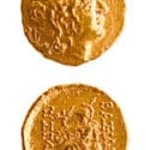Gold Stater Issued Under King Mithradates VI, 88 BCE - 86 CE
Gold
C.2261
Obverse: Portrait of Deified Alexander the Great Reverse: Athena Seated Facing Left Holding Nik Mithradates VI, called “the Great,” was the legendary King of Pontus, a region in what is...
Obverse: Portrait of Deified Alexander the Great
Reverse: Athena Seated Facing Left Holding Nik
Mithradates VI, called “the Great,” was the legendary King of Pontus, a region in what is now northeastern Turkey. Bitter enemy of the Romans, with whom he fought three wars between 88 and 63 B.C., Mithradates envisioned himself as the protector of the Greeks of Asia Minor. At the height of his power he controlled much of Asia Minor and Greece, choosing Pergamon as his capital and royal residence. His reign commences about 121 B.C., when, at the age of eleven, he succeeded his father, Mithradates V. He quickly seized Colchis and the Crimea from the Scythians; yet his attempts to cement control in Paphlagonia and Cappadocia were thwarted by Rome. Soon after, an unsuccessful plot to depose Nicomedes III of Bithynia provoked raids on Pontic territory in 88 that would ultimately lead to the First Mithradatic War. Since most of Mithradates' coins are dated, the origin of this stater can be traced to 88-86 B.C., the time of this first war. Rome eventually forced him to give up his conquered territory, pay a huge indemnity, and retreat to his original borders. The Second Mithradatic War erupted after the Roman invasion of Pontus in 83. However, this invasion was quickly repelled by the next year. The Roman design to annex Bithynia provoked the Third Mithradatic War. Mithradates occupied Bithynia, but in 73 B.C. his army, isolated from reinforcements, was destroyed by the Romans. In 66, after regaining most of his territory, Mithradates was finally defeated by Pompey the Great who cleared the way for Roman domination. Shortly thereafter, while hatching a plan for the invasion of Italy from the north, Mithradates died.
How many hands have touched a coin in your pocket or purse? What eras and lands have the coin traversed on its journey into our possession? As we reach into our pockets to pull out some change, we rarely hesitate to think of who might have touched the coin before us, or where the coin will venture to after it leaves our hands. More than money, coins are a symbol of the state that struck them, of a specific time and location, whether contemporary currencies or artifacts of a long forgotten empire. This stunning hand-struck coin reveals an expertise of craftsmanship and intricate sculptural detail that is often lacking in contemporary machine-made currencies. Like many leaders, Mithradates adopted the imagery of Alexander the Great in order to bolster his legitimacy as a ruler and to appeal to the Greek citizenry residing in Asia Minor. This magnificent coin is more than a memorial to a leader; it is an artifact of a kingdom passed from the hands of civilization to civilization, from generation to generation.
Reverse: Athena Seated Facing Left Holding Nik
Mithradates VI, called “the Great,” was the legendary King of Pontus, a region in what is now northeastern Turkey. Bitter enemy of the Romans, with whom he fought three wars between 88 and 63 B.C., Mithradates envisioned himself as the protector of the Greeks of Asia Minor. At the height of his power he controlled much of Asia Minor and Greece, choosing Pergamon as his capital and royal residence. His reign commences about 121 B.C., when, at the age of eleven, he succeeded his father, Mithradates V. He quickly seized Colchis and the Crimea from the Scythians; yet his attempts to cement control in Paphlagonia and Cappadocia were thwarted by Rome. Soon after, an unsuccessful plot to depose Nicomedes III of Bithynia provoked raids on Pontic territory in 88 that would ultimately lead to the First Mithradatic War. Since most of Mithradates' coins are dated, the origin of this stater can be traced to 88-86 B.C., the time of this first war. Rome eventually forced him to give up his conquered territory, pay a huge indemnity, and retreat to his original borders. The Second Mithradatic War erupted after the Roman invasion of Pontus in 83. However, this invasion was quickly repelled by the next year. The Roman design to annex Bithynia provoked the Third Mithradatic War. Mithradates occupied Bithynia, but in 73 B.C. his army, isolated from reinforcements, was destroyed by the Romans. In 66, after regaining most of his territory, Mithradates was finally defeated by Pompey the Great who cleared the way for Roman domination. Shortly thereafter, while hatching a plan for the invasion of Italy from the north, Mithradates died.
How many hands have touched a coin in your pocket or purse? What eras and lands have the coin traversed on its journey into our possession? As we reach into our pockets to pull out some change, we rarely hesitate to think of who might have touched the coin before us, or where the coin will venture to after it leaves our hands. More than money, coins are a symbol of the state that struck them, of a specific time and location, whether contemporary currencies or artifacts of a long forgotten empire. This stunning hand-struck coin reveals an expertise of craftsmanship and intricate sculptural detail that is often lacking in contemporary machine-made currencies. Like many leaders, Mithradates adopted the imagery of Alexander the Great in order to bolster his legitimacy as a ruler and to appeal to the Greek citizenry residing in Asia Minor. This magnificent coin is more than a memorial to a leader; it is an artifact of a kingdom passed from the hands of civilization to civilization, from generation to generation.
1
of
3



